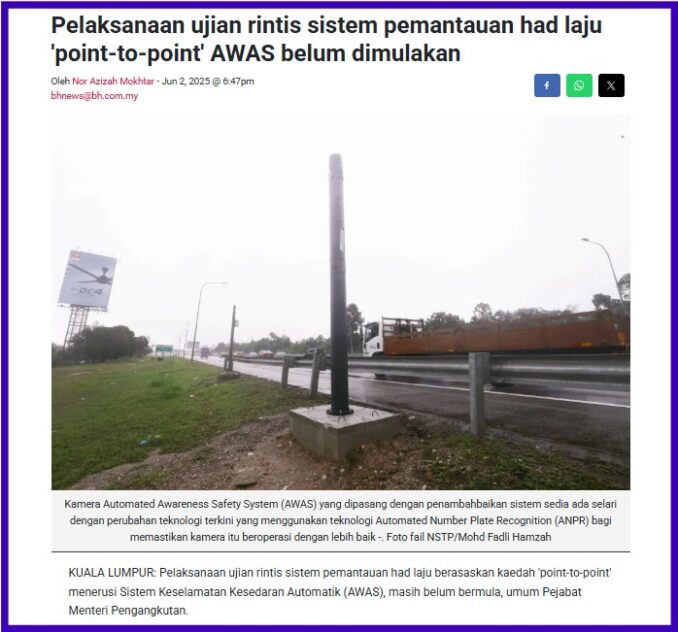SPEED kills.
Everyone knows it but too many motorists ignore the prescribed speed limits.
With a variety of navigation tools being able to alert drivers of speed traps, it has become imperative that a new deterrent be found.
The latest anti-speeding devices was shared on X by Abang aji (@aponakdikato) who detailed out that the new-fangled Automated Awareness Safety System (AWAS) calculates the average speeds between two points.
SISTEM SPEED TRAP TERKINI BERMULA 1 JUN 2025
Mulai 1 Jun 2025, pihak berkuasa akan mengaktifkan sistem AWAS: Pengesanan Kelajuan Purata Titik-ke-Titik di lebuh raya utama.
Sistem ini akan mengira purata kelajuan berdasarkan masa perjalanan antara plaza tol ke plaza tol.
1/2 pic.twitter.com/7YKAg05sA7
— Abang aji🪵 (@apanakdikato) June 2, 2025
If a motorist arrives at a certain destination faster than the average time required to cover the distance, it will be surmised that the speed limit was NOT observed. “A court summon will duly be served as opposed to an ordinary summon,” warned the poster.

He went on to share the location of these cameras along the North-South Expressway (PLUS).
According to media reports, the new AWAS system is set to begin pilot testing on two highways: the KL-Karak Expressway and the North-South Expressway starting in June.
Editor’s Note: But the latest media report by Berita Harian citing Transport Minister Anthony Loke Siew Fook’s office stated that the trial dates for AWAS have not yet been ascertained.
This is despite back in March, the Transport Ministry’s secretary-general Jana Santhiran Muniayan having mentioned that the AWAS trials would kick off in June.

On the KL-Karak Expressway, the AWAS speed camera will monitor speed limits of motorists travelling between the Genting Sempah tunnel and the Gombak Rest and Relaxation Area.
On the North-South Expressway, the test run will cover the stretch from the Senawang toll plaza to the Simpang Ampat toll plaza in June.
The reaction online was decidedly mixed with some motorists eager for a system that can catch speed demons while motorists who like to floor it are circumspect.
One netizen reckoned that it would be best if a vehicle had cruise control, allowing the driver to maintain a constant speed that is below the prescribed limit.

Another simply remarked that he would have “to make a couple more stops at various R&Rs” to prolong his travel time.

However, one motorist could not hide his contempt over such attempts to nab speed demons, stating that no such attempts were made to enforce road safety regulations.
He was alluding to heavy vehicles and possibly the recent accident that claimed nine Federal Reserve Unit (FRU) members’ lives.

This was a good idea noted one netizen who however questioned if it would be truly effective. He counselled that an awareness campaign would be better suited.

Forget about racing-oriented or performance vehicles was the advice proffered by another netizen. Better to focus on fuel-saving models was the pertinent point.

But as pointed out by one commenter, this was just a pilot scheme with full roll-out further down the line – possibly in September 2025.

Typical of Malaysians, there will be loud calls for stern action whenever a road tragedy occurs such as the aforementioned crash involving a FRU truck.
But when possible solutions are suggested, they are met with scepticism and grumblings of it being heavy-handed.
Malaysian motorists need to choose – safety over speed or vice versa. It just doesn’t go both ways. – June 4, 2025









